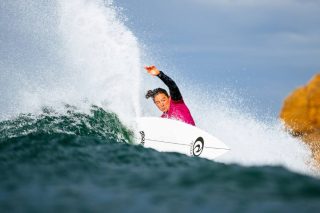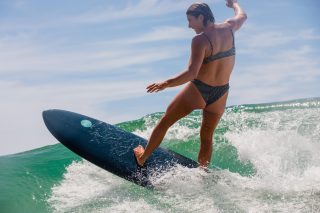Men in dark suits, wearing grim expressions and discrete ear-pieces are pacing the perimeter of the Freshwater Surf Club, muttering into their lapels and looking as if they are prepared to hurl themselves in the path of a bullet if required.
I’d heard Duke Kahanamoku’s famous board was going to make a rare public appearance outside its Perspex case for the occasion but I hadn’t expected this sort of security blitz.
The occasion in question is the launch of Surfing Australia, the book written by Phil Jarratt to celebrate the 50th anniversary of the organization of the same name. It turns out the security isn’t for Duke’s board but for the celebrity guest brought in to officially launch the weighty historic tome – none other than acting Prime Minister and Treasurer Wayne Swan.
If you ever wanted evidence that surfing has become mainstream, here it is. With Julia Gillard overseas, Swan is effectively running the country yet he appears delighted to take time out for his buddies at Surfing Australia. Both Swan and opposition leader Tony Abbott are eager to flaunt their surfing credentials these days, in a bid to bolster their everyman appeal. Only a few days before, Abbott had been gamely flailing about on a longboard at Manly in support of a Surf Aid fundraiser.
Any purists out there clinging to notions of surfing as a subversive, counter-culture activity might cringe at surfing’s rise to respectability, but this is all extremely good news to Surfing Australia’s CEO Andrew Stark.
Under Stark’s strategic and determined leadership, Surfing Australia has evolved from a staid, conservative administrative body to a dynamic and rapidly growing business. Stark’s stated aim is to take surfing into the households of middle Australia as a fully-fledged mainstream sport, challenging cricket, tennis and the footy codes for the hearts and minds of our sports mad nation. And the 50th anniversary of Surfing Australia provides a golden opportunity to tell the world how close to success this mission is.
While the rest of the surf industry struggles with the unremitting doom and gloom of falling share prices, take over bids, job lay-offs and retail closures, business is booming at Surfing Australia.
Annual turn over has doubled from $2 million to $4 million in two years and is forecast to only keep growing. Surfing has achieved “priority sport status” from the Australian Sports Commission and recently received $4 million funding over four years. A beaming Wayne Swan was also called upon recently to open the $4 million, High Performance Centre at Casuarina, in northern NSW. High profile sponsors like Telstra, Vegemite, Victoria Bitter, Nikon and Suncorp have boosted the coffers and eased Surfing Australia’s reliance on the beleaguered surf brands.
The Surfing Australia logo appears on 25 million cases of VB alongside the NRL and Cricket Australia, and on 1.5 million jars of Vegemite next to the Olympic symbol. The Australian mint has just released a special 50th anniversary commemorative 50-cent piece, and a special series of Surfing Australia stamps are about to be issued by Australia Post, featuring Layne Beachley and Midget Farrelly. Surfing Australia accredited surf schools have introduced 500,000 newcomers to the surf, and a new junior program, Surf Groms, is giving the surf clubs’ Nippers a run for their money. Surfing Australia now has its own prime time TV show and twice-yearly magazine.
If you are worried about crowds in the water, you may not regard Surfing Australia as a saviour. But if you are wondering where future growth might come from for the surf industry in these uncertain times, the multi-pronged activities of Surfing Australia may just provide some welcome cause for optimism.
“I think what we’re doing has a direct beneficial effect on the surf retail industry,” says Stark. “Our target primarily for Surf Groms is about reaching families and reaching communities that wouldn’t otherwise be involved in surfing … So, we’re bringing them into the sport and as soon as you bring them in and they engage and have a favourable experience then they want to buy boardshorts and subscribe to magazines and get on to Coastalwatch and get involved in the sport and follow the tour. And at the end of the day, it all leads to them wanting to be a surfer, which means they need to buy surfboards and look the part, get into the boardies and get a rash vest and wetsuit.”
While Surfing Australia is busily wooing new grommets into the waves they are also striding the corridors of power and winning influence with our elected leaders. Some of you might have spotted a photo recently of Stark, along with surf champs Rabbit Bartholomew, Layne Beachley, Tom Carroll and Sally Fitzgibbon posing with Prime Minister Julia Gillard. This was taken on the night Stark took the surfers to Canberra to speak at a dinner with Members of the Federal Parliament, the first time a so-called “second tier” sport has been granted such an audience.
“The other positive effect I think we’ve had on the retail industry is just the profile we’re creating. We’ve had this distinct strategy to become more mainstream, and to us more mainstream isn’t just about more revenue into the business,” says Stark. “Any opportunities where we can get a mainstream audience and households in Australia engaged in surfing I think is a benefit for the surf retail industry.”
Yet, it wasn’t so long ago that Surfing Australia was “effectively broke,” according to chairman Norm Innis. He gives Stark much of the credit for the extraordinary turn around. Central to that turn-around was a new governance model and the appointment of a new, independent board, balancing corporate know-how with surfing credentials. On the surfing side are seven-time women’s world champ Layne Beachley, respected surf journalist Sean Doherty and Surfing Victoria life member Mal Gregson. On the corporate side are Matt Finnis, CEO of the AFL Players Association; Don O’Rourke, managing director of Consolidated Properties; and Rob Combe, a former Group Executive at Westpac. Chairman Norm Innis is a former general manager of Quiksilver International.
“The number one thing that we identified was the need to really embrace change,” says Stark, “so it was a really big cultural shift in the way we did business and the way our team operated, both from a governance board perspective and from our whole management team and staff. The whole organization had to understand that we really needed to have dramatic change to be able to compete in the Australian sporting landscape, to be able to build a sustainable business … Surfing Australia’s 50 years old and it had a certain structure and a certain way of doing things and in many ways it worked. But to really grow and go to the next level and really, I suppose, be able to grow in the economic environment we were in it really needed to embrace change and that was the big lesson that we learnt.”
Could Surfing Australia’s experience contain lessons for the rest of the surf industry? “I’m not a surf retail expert, I’m a sporting administrator,” Stark cautions. Even so, embracing change in changing times is his key message.
“I think in some ways the surf industry have done what they did well in a certain era and they perhaps haven’t changed enough to stay current and stay relevant to the customer base now,” he offers. “If you’ve got a big business with a lot of people who have been there for a long time who have always done it a certain way it’s very hard to change their mindset … This is the way we’ve been doing things for 20 years and we sold a shitload of boardshorts but maybe we need to think completely differently about how we’re going to reach these people and how we’re going to sell them boardshorts and t-shirts and caps.”
Stark comes from an ad agency background and many of the mainstream brands he now deals with use ad agencies to oversee their marketing and ensure they remain on the cutting edge. “I talk to a lot of agencies that work with these big brands and what they did five years ago to what they do now to reach customers is absolutely categorically completely different. Because what they were doing five years ago is no longer working,” he says. “So, staying in tune with the changing consumption of content on iPhones and iPads is vital. And the research is phenomenal in Australia in the use of iPhones – 78% of Australians say they don’t leave home without their iPhone, and a massive percentage of those say they check their iPhone before they get out of bed. 23% of Australians say they would rather give their TV up than their iPhone. It is starting to effect the way people live, so I think that some of the older traditional marketing forms simply don’t work any more and you need to be really relevant and stay up with the times.”
At times, he suggests, the surf industry may have been too insular for its own good. “A lot of the surf brands have internal marketing departments and some of the brands we use, they all have ad agencies … The advertising agency industry, they are forced into staying completely current and relevant because they are all in competition with all the Mojos and McCanns, and all those different ad agencies are in competition to get the business of these big brands. And the only way they can be able to provide competitive solutions for these brands is to be on top of the game and to be instantly innovating and constantly pioneering what customers want and how to reach customers. In a lot of cases surf companies rely on themselves as their own marketing departments and they employ internally … Maybe you might see into the future more agency consulting and working in that space to be able to try and stay competitive, just be able to reach your customers in the relevant way that they want to be reached, and that right now is changing weekly.”
The other thing Surfing Australia has done is commission thorough research from leading market research firm, Gemba, to learn “where we sit in the scheme of Australian sport.”
“You’ve always got to have the gut feeling in business but you’ve also got to have the research,” he says. That research helped them identify a large, younger demographic that was being under-serviced and gave rise to the Surf Groms program. “There’s a huge market of kids from 8, 9 years old. Our research is showing a much younger demographic that are interested in the sport, but also an older bracket, 40 plus, where there’s genuine interest – not just people that say they’re surfers, but who want to learn to surf and get involved in the sport.”
With that in mind, he suggests, the surf industry may need to become better at welcoming complete novices into the sport, to provide an educational retail experience that assumes no prior knowledge on the part of the customer.
“It’s that positive consumer engagement with really educated staff who have got the ability to provide a retail engagement or experience where the customer’s really learning and you’re not just selling them a product,” he says. Surfboards are a good example where the newcomer might feel intimidated. “You can start talking about rail thickness or bottom rocker and they don’t know what you’re talking about. There’s a great opportunity to provide a retail experience that is educational. Look at Apple. You go into one of their stores, it’s all about going in there and learning what their products are … What does it do for me and how can it make my life better?”
Comparing surfboards to iPhones might make some traditionalists bristle, and even some surf brands have privately expressed misgivings about Surfing Australia’s quest to take surfing “mainstream.” If surfing loses its edgy cool factor, one surf marketer told me, then the surf brands lose their point of difference and are competing with Cotton on Kids and Jeans West.
Stark argues the days of surfing being a renegade, counter-culture past-time are long gone, yet at the same time he believes surfing will never lose its appeal. “I can understand the need for surfing to remain core and be aspirational and I think surfing’s always going to have that cool factor and that essence of the environment and the ocean and freedom. It’s a unique sport in that way, it’s got a lot of elements to it that many other sports don’t have. But from a mainstream perspective these are big public companies, most of these surf brands, and they’re on the stock exchange, they’re in huge department store chains some of them, and even if they’re not in department stores they’re in shops that are in massive Westfield shopping malls in inner city Melbourne. I would suggest they are all selling to a mainstream audience.”
For a sporting body chasing government funds and corporate sponsorship, Stark says Surfing Australia has no choice but to head mainstream. “It’s one thing to say that you want to remain core but there’s a big market out there and one thing from a sport perspective, becoming mainstream in the sporting landscape in Australia is incredibly competitive … We’re sports mad. But that also means we’re incredibly competitive for revenue at every level, in terms of private sector and government. As a sport, unless you’re prepared to try and become mainstream and reach the masses you can’t compete.”
On a personal level, though, it’s hard to argue with Stark’s core credentials. A passionate, life-long surfer, his annual Hawaii trip sees him charging huge Sunset and Waimea. Whatever you might thing of his mission to mainstream surfing, no one can accuse Stark of being an office-bound desk jockey out of touch with the essence of surfing. “My favourite wave in the world is Sunset. I’ve had my best sessions there. When you get a big north-west peak that bowls up all the way through and then get a standup barrel through inside bowl, there’s not much better in life than that. So you’re just sort of hunting for that the whole time.”
At work, you’d be hard pressed to describe Stark as a surfing “purist,” but in the water it’s a different story. “I’m not really into towing. It hurts the body too much. I just like the sensation of taking the drop and the whole thing. I’m not a big tow fan.”
Or maybe Stark’s approaches on land and water have more in common than it appears at first glance. In both realms, he likes to go big, doesn’t back down from a challenge and isn’t afraid of paddling into the impact zone and putting himself in the path of danger. How else could you explain his decision to allow US surf brand Hurley to buy naming rights for Surfing Australia’s highly vaunted High Performance Centre, to the horror of Australian surf brands? As Stark tells it, Hurley came to him with the concept of aligning themselves with the HPC, but that didn’t stop the other major surf labels venting their displeasure.
He again took on the major surf labels when he tried to package the Australian leg of the ASP tour into a “Grand Slam of Surfing” like the Hawaiian Triple Crown, with the backing of Telstra. The large and ambitious deal involved packaging the on-line, mobile and IP TV rights to the major events in Australia for Telstra to broadcast. This time though, Stark couldn’t work through the surf brands’ objections to the deal and Telstra walked away. “There were a lot of barriers to get that over the line. The appetite from Telstra was there to get into that surfing space … It was a big, significant deal revenue-wise for the sport and for Surfing Australia. It would have been a massive boost in terms of our capacity and so on.” Stark sees it as an opportunity lost for surfing in general, and symptomatic of the fragmented nature of ASP sponsorships, where individual event sponsors own their own media rights and on-sell their own supporting sponsorships. “It’s completely convoluted for a sponsor like Telstra to understand and we tried to break those barriers down and create a clean package but in the end I think it became too challenging for them to see their way through some of the stipulations that some of the surf brands wanted to put in place in terms of content and advertising.”
Stark is hopeful the new deal with ZoSea Media, which has seen the largely unknown US media group virtually acquire ASP, will address some of those issues. But like a lot of people, he is keen to see more detail. “The new path with this new American privatization model will hopefully provide some clarity for our sport and a less segmented sporting package, so to speak,” he says. “I’d like to see more information … I would think as a CEO of a national sporting organization … that we would be given all of the information and told exactly what’s happening and we’ve been given bits and pieces but where’s the clear definitive statement of exactly what this means for surfing? Because I don’t think that’s been released yet.”
The other area of ASP operations that has Stark concerned is the collapse of the pro junior series and the resultant loss of a career stepping stone for young surfers. “It was 13 events last year and it’s gone down to three events. I think there’s a few reasons there. Obviously the whole surf industry, they propped up that whole junior series for many, many years. It was all pretty much driven by surf brands. Out of 13 events 10 of them were surf brands and now there’s three events left. Brands are looking harder at return on investment and where they spread their money.”
ASP International took back the management of ASP Australasia from Surfing Australia two years and, Stark argues, it is no coincidence the pro junior series went into decline. “I think their focus has been the top end, the men’s world tour, and they’re trying to get women’s events back, and they’ve had this whole top end deal with ZoSea to negotiate. So, are they looking at the junior and longboard circuits? How can they with the resources they’ve got? … Once we lost that business, our focus became things like Surf Groms and the High Performance Centre and boardriders clubs and a lot of those different things. Now it’s more a sport development obligation that we need to get involved and try and resurrect the ASP pro junior series so there’s a pathway there.”
Surfing Australia now oversees a vast range of programs – from Surf Groms, to boardriders clubs (a new national club competition is planned), surf schools to the High Performance Centre, coaching accreditation to training camps to national teams. Their mission to take surfing mainstream centres on attracting more people to surfing and producing more champion surfers. Stark says there is credible research that puts the number of surfers in Australia at 2.5 million and rising. Whether you think attracting more surfers to our already crowded surf zones is a good thing or not is another matter. Government clearly does, recognizing surfing’s healthy, whole of life appeal as a significant public health benefit. Where other sports people might retire after a competitive career, surfers tend to continue riding waves well into later life. And as our population ages, having more healthy senior citizens who are less of a burden on the health and aged care systems is seen as an enormous plus.
Despite plummeting share prices and retail woes, Stark reckons there is plenty of life left in brand surf yet. “Absolutely. The surf retail industry is really healthy in its ability to affect great experiences in people’s lives and provide that sort of surfing experience even if people can’t get in the water … to feel like they are part of a lifestyle or a movement,” he effuses. “There’ll always be a place for surf retail. In these times you’ve just got to be really smart about how you do business, the basics of making sure you’ve got the right people and the right processes … You’re only as good as your people. I’ve seen the surf industry over the years carry a lot of people that mightn’t have been quite suitable for roles … The fundamental thing abut running a business is knowing you have really good people and you know absolutely and categorically that you can trust them and you can stand by them and they’re bloody good at their job.”









